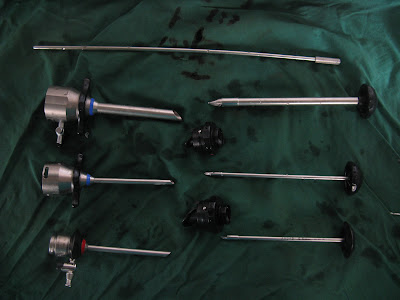Laparoscopic cholecystectomy
This is a widely used procedure in general surgery. Prior to surgery the procedure is explained to the patient and informed written consent is taken. The appropriate assessment of patient’s fitness for surgery is carried out. This includes investigation of cardiovascular and respiratory system if history suggests these to be risk factors, a full blood count and biochemical profile. Blood coagulation is checked if there is history of jaundice.
At the operating theatre the patient is positioned in the operating table. The patient is given prophylactic antibiotics at the time of induction. The patient is anaesthetized. And pneumoperitoneum is created. Four ports are placed in the abdomen.
The cystic duct and cystic artery are carefully defined. Then the cystic duct is clipped and divided and the gallbladder is removed from the bed then removed from the body via the umbilicus.
Then the co2 is removed and trocars are withdrawn. The access sites are sutured. Other practices of laparoscopy in General surgery.
• Diagnostic Laparoscopy
• Appendectomy
The surgeon typically stands on the left of the patient, and the assistant stands on the right. The standard approach is to place 3 trocars during the procedure. Two of these have a fixed position ( umbilical, suprapubic); the position of the third, which is placed in the right periumbilical region, may vary greatly depending on the patient's anatomy. After gaining access the whole abdomen is visualized and the appendix is identified.
• Hernia Repair.
The port placement differ according to the site of the hernia
• Spleenectomy
• Anti-Reflux Procedures
The most common anti-reflux surgical procedure performed for treatment of GORD is a Nissen fundoplication . The fundus of the stomach is wrapped around the lower portion of the esophagus and anchored securely below the diaphragm. If there is a hiatal hernia, the hernia will also be fixed using a laparoscope and five small incisions
• Paraesophageal Hernia Repair
• Gastric Procedures
Since the advent of H2-receptor blockers and proton pump inhibitors elective surgery for ulcer disease is unusual, but in emergency surgery for complications such as perforation and gastric outlet obstruction, laparoscopic procedures are appropriate. These procedures include primary repair with omental patch for perforation and gastrojejunostomy bypass in cases of obstruction. Management of bleeding by laparoscopic techniques is not being done but Laparoscopic gastrectomy for benign and malignant gastric tumors has been done
• Small Bowel Procedures
• Colorectal Surgery


.jpg)





